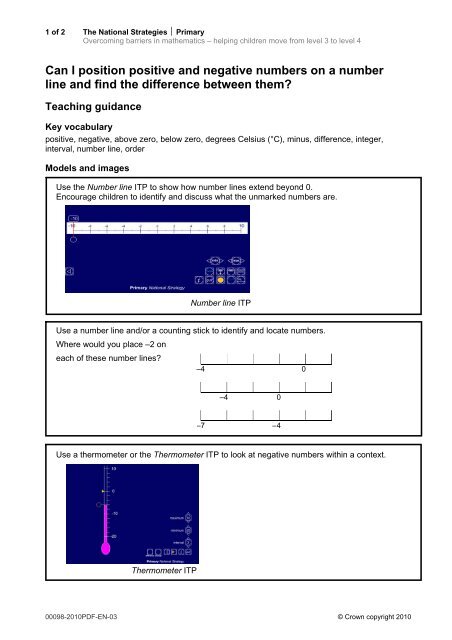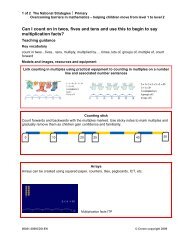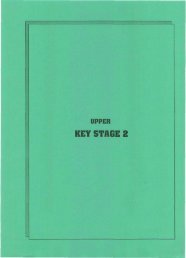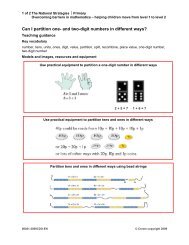Position positive and negative numbers - Steps to success in ...
Position positive and negative numbers - Steps to success in ...
Position positive and negative numbers - Steps to success in ...
Create successful ePaper yourself
Turn your PDF publications into a flip-book with our unique Google optimized e-Paper software.
1 of 2 The National Strategies PrimaryOvercom<strong>in</strong>g barriers <strong>in</strong> mathematics – help<strong>in</strong>g children move from level 3 <strong>to</strong> level 4Can I position <strong>positive</strong> <strong>and</strong> <strong>negative</strong> <strong>numbers</strong> on a numberl<strong>in</strong>e <strong>and</strong> f<strong>in</strong>d the difference between them?Teach<strong>in</strong>g guidanceKey vocabulary<strong>positive</strong>, <strong>negative</strong>, above zero, below zero, degrees Celsius (°C), m<strong>in</strong>us, difference, <strong>in</strong>teger,<strong>in</strong>terval, number l<strong>in</strong>e, orderModels <strong>and</strong> imagesUse the Number l<strong>in</strong>e ITP <strong>to</strong> show how number l<strong>in</strong>es extend beyond 0.Encourage children <strong>to</strong> identify <strong>and</strong> discuss what the unmarked <strong>numbers</strong> are.Number l<strong>in</strong>e ITPUse a number l<strong>in</strong>e <strong>and</strong>/or a count<strong>in</strong>g stick <strong>to</strong> identify <strong>and</strong> locate <strong>numbers</strong>.Where would you place –2 oneach of these number l<strong>in</strong>es?–4 0–4 0–7 –4Use a thermometer or the Thermometer ITP <strong>to</strong> look at <strong>negative</strong> <strong>numbers</strong> with<strong>in</strong> a context.Thermometer ITP00098-2010PDF-EN-03 © Crown copyright 2010
2 of 2 The National Strategies PrimaryOvercom<strong>in</strong>g barriers <strong>in</strong> mathematics – help<strong>in</strong>g children move from level 3 <strong>to</strong> level 4Teach<strong>in</strong>g tipsGive children a range of opportunities <strong>to</strong> position <strong>positive</strong> <strong>and</strong> <strong>negative</strong> <strong>numbers</strong> onnumber l<strong>in</strong>es. This could <strong>in</strong>clude the use of practical wash<strong>in</strong>g l<strong>in</strong>es, count<strong>in</strong>g sticks <strong>and</strong><strong>in</strong>dividual number l<strong>in</strong>es.Make sure that children experience number l<strong>in</strong>es <strong>in</strong> different orientations.Use a range of count<strong>in</strong>g activities with different start<strong>in</strong>g po<strong>in</strong>ts <strong>and</strong> step sizes <strong>to</strong>emphasise that count<strong>in</strong>g cont<strong>in</strong>ues beyond zero. Use number l<strong>in</strong>es <strong>to</strong> show the relativeposition between pairs of <strong>negative</strong> <strong>numbers</strong> <strong>and</strong> <strong>to</strong> demonstrate that –4 is less than –2.Help children <strong>to</strong> use the benchmark <strong>numbers</strong> on a number l<strong>in</strong>e <strong>to</strong> determ<strong>in</strong>e the position ofother <strong>numbers</strong> on that number l<strong>in</strong>e.Help children <strong>to</strong> make connections between us<strong>in</strong>g benchmark <strong>numbers</strong> on a number l<strong>in</strong>e<strong>and</strong> read<strong>in</strong>g the scale on a thermometer.Use <strong>negative</strong> <strong>numbers</strong> <strong>in</strong> other contexts, for example, ‘A diver is below the surface of thewater at –30 m. He goes up 12 metres, then down 4 metres. Where is he now?’00098-2010PDF-EN-03 © Crown copyright 2010










